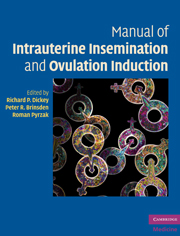Book contents
- Frontmatter
- Contents
- List of contributors
- Preface
- 1 An overview of intrauterine insemination and ovulation induction
- 2 Male causes of infertility: evaluation and treatment
- 3 Female causes of infertility: evaluation and treatment
- 4 Clinic and laboratory design, personnel and equipment
- 5 Semen analysis: semen requirements for intrauterine insemination
- 6 Semen preparation for intrauterine insemination
- 7 Ovulation induction for intrauterine insemination I: oral drugs clomiphene, tamoxifen, letrozole
- 8 Ovulation induction for intrauterine insemination II: gonadotropins and oral drug–gonadotropin combinations
- 9 Ultrasonography in the management of ovulation induction and intrauterine insemination
- 10 Insemination technique and insemination complications
- 11 Cryopreservation
- 12 Donor sperm
- 13 The role of the nurse in intrauterine insemination and ovulation induction
- 14 Complications of ovulation induction I: high-order multiple births, miscarriage, ectopic pregnancy, congenital anomalies, ovarian cancer
- 15 Complications of ovulation induction II: ovarian hyperstimulation syndrome, ovarian torsion
- 16 The psychological issues of intrauterine insemination
- 17 Ethical, legal and religious considerations of artificial insemination
- Index
15 - Complications of ovulation induction II: ovarian hyperstimulation syndrome, ovarian torsion
Published online by Cambridge University Press: 01 February 2010
- Frontmatter
- Contents
- List of contributors
- Preface
- 1 An overview of intrauterine insemination and ovulation induction
- 2 Male causes of infertility: evaluation and treatment
- 3 Female causes of infertility: evaluation and treatment
- 4 Clinic and laboratory design, personnel and equipment
- 5 Semen analysis: semen requirements for intrauterine insemination
- 6 Semen preparation for intrauterine insemination
- 7 Ovulation induction for intrauterine insemination I: oral drugs clomiphene, tamoxifen, letrozole
- 8 Ovulation induction for intrauterine insemination II: gonadotropins and oral drug–gonadotropin combinations
- 9 Ultrasonography in the management of ovulation induction and intrauterine insemination
- 10 Insemination technique and insemination complications
- 11 Cryopreservation
- 12 Donor sperm
- 13 The role of the nurse in intrauterine insemination and ovulation induction
- 14 Complications of ovulation induction I: high-order multiple births, miscarriage, ectopic pregnancy, congenital anomalies, ovarian cancer
- 15 Complications of ovulation induction II: ovarian hyperstimulation syndrome, ovarian torsion
- 16 The psychological issues of intrauterine insemination
- 17 Ethical, legal and religious considerations of artificial insemination
- Index
Summary
Introduction
Ovarian hyperstimulation syndrome (OHSS) is characterized by bilateral, multiple follicular and thecalutein ovarian cysts and an acute shift in body fluid distribution resulting in ascites Fig. 15.1. OHSS in patients undergoing controlled ovarian hyperstimulation has been observed to occur in two distinct forms, early onset and late onset, with possibly different predisposing factors. Early OHSS presents 3–7 days after the ovulatory dose of human chorionic gonadotropin (hCG), whereas late OHSS presents 12–17 days after hCG. Early OHSS relates to an “excessive” preovulatory response to stimulation, whereas late-onset OHSS depends on the occurrence of pregnancy, is more likely to be severe and is only poorly related to preovulatory events. Rizk and Smitz, in an analytical study of the factors that influence the incidence of OHSS, found a wide variation among different centers. This is partly because of different definitions of the grades of severity and partly because of the adoption of different criteria for its prevention. The incidence of OHSS has been estimated at 20–33% for mild cases, 3–6% for moderate cases and between 0.1% and 2% for severe cases.
Overview of OHSS classifications
There has been no unanimity in classifying OHSS, and divergent classifications have made comparisons between studies difficult. Aboulghar and Mansour reviewed the classifications used for OHSS over the last four decades and included as many as six categories of severity. The most recent classification was introduced in 1999 by Rizk and Aboulghar.
- Type
- Chapter
- Information
- Manual of Intrauterine Insemination and Ovulation Induction , pp. 151 - 159Publisher: Cambridge University PressPrint publication year: 2009



